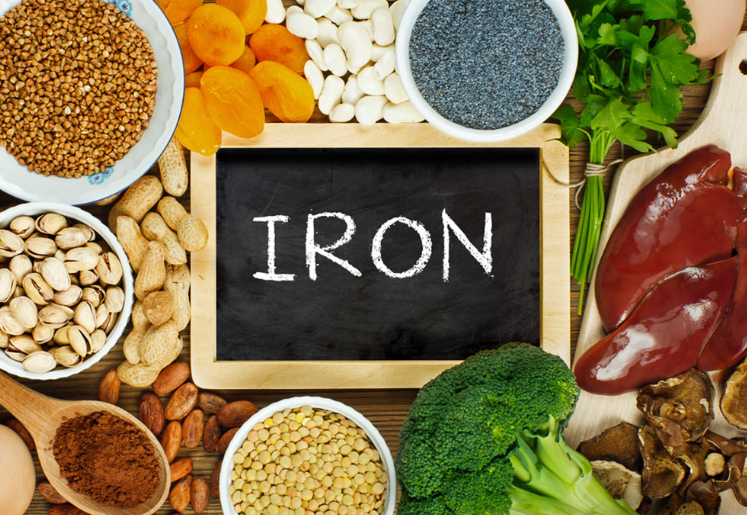Importance of Iron
Picture this: you’re in the middle of the championship game or race, and you’re about to make a big move. However, when your mind tells your body to do it, your body doesn’t respond. What you’re experiencing is most likely fatigue, which is the most tell-tale sign that you are experiencing iron deficiency. In this article, we will be going over iron basics, how it helps the body run, and how you can supplement it into your daily diet.
The Basics of Iron
Iron is a super important nutrient that naturally occurs in many foods, and is even incorporated into some of your favorite foods like cereal. This vital mineral is a primary element of hemoglobin, the red blood cells that carry oxygen and nutrients throughout the body. Iron is also included in myoglobin, which are the muscle cells that accept, store, transport, and release oxygen. About 70% of your iron consumption is used to create these vital cells.
The rest of iron consumption is found in ferritin proteins, which circulate the body in blood flow and store the iron until later needed for more hemoglobin production. Ferritin is a common item to be included in blood tests, as it is a good indicator of iron levels and if you need to be concerned about iron deficiency. As for many nutrients, there are cases where having too little or too much ferritin can be a bad thing.
Most commonly seen is when people are lacking in ferritin stores, and therefore total iron levels. Low Ferritin can be associated with symptoms such as:
Fatigue
Dizziness
Trouble sleeping and concentrating
Pale skin
Frequently feeling colder than usual
Rapid heart rate
These symptoms, as well as tests with results that are generally lower than the numbers above, are often associated with iron deficiency as well as anemia. Anemia is a cardiovascular disorder that is caused when the body is unable to create enough hemoglobin, which may be from a variety of causes such as iron deficiency.
High ferritin levels are much harder to achieve and diagnose. Symptoms included aren’t caused by the exceeding amount of iron, but rather the conditions that cause them. The main condition that is related to high ferritin levels is hemochromatosis. Hemochromatosis is usually caused by genetic change, but can also be caused by improper blood transfusions and liver diseases. Symptoms can include fatigue, joint pain, and rusty or gray skin. If untreated, hemochromatosis results in liver damage and heart failure.
Luckily, in the case of most athletes, consuming too much iron is a very rare instance, as the body uses iron significantly faster during physical activity. Unless diagnosed with a disorder that leads to the over-absorption of iron, athletes really should focus on consuming as much iron as possible, because it is the major component in transporting nutrients and oxygen to muscles.
Iron consumption issues are most common in women, due to the blood loss during menstrual cycles. It’s for this reason why women’s ferritin stores are often less than men, and why it is even more important for women to make sure they’re consuming enough iron in their diets. Most symptoms related to iron deficiency are seen in women, so if you are thinking that you may be experiencing these symptoms, you may want to go to your local pharmacy and get some iron supplement pills.
If you are curious about getting your blood tested for ferritin levels, most practitioners and walk-in clinics can arrange for a lab to be done. The trick, however, is that they usually won’t test your blood unless there is some kind of medical concern. When bringing up the subject, bring up that you have had a family history of anemia (which is probably true, because almost 25% of the population has anemia!).
How to Incorporate Iron:
Now that we know why iron is so important, how can we include more iron-dense foods in our diets? The recommended amount of iron differs for everyone, but you can reference the chart below to see what you ideally should be consuming.
Once you find the ideal amount of iron you want to consume every day, it’s time for the fun part: Eating!
Iron-Dense Foods:
Oysters (6.9 mg/3 oysters)
Cooked Lean Beef (2.5 mg/3-ounce portion)
Cream of wheat (12.8 mg/1 cup)
Ready-to-eat cereal, toasted oat, fortified (9 mg/1 cup)
Soybeans (8.8 mg/1 cup)
White beans (8 mg/1 cup)
Lentils (6.6 mg/1 cup)
Spinach (6.4 mg/1 cup)
Chickpeas (4.8 mg/1 cup)
Dark chocolate (70% to 85% cocoa) (2.3 mg/1 ounce)
The most common source of iron in the average person’s diet comes from beef and other red meats, due to its prominence in cuisine and high amounts of blood in the meat. People with dietary restrictions that limit them from eating red meats, such as vegetarians or certain religious believers, must keep these other options as key ingredients in their meals to promote healthy iron levels.
Conclusion:
Iron is a key part of creating the red blood cells that transfer nutrients and oxygen throughout the body. It is important to monitor and regulate iron levels in the body by getting your iron levels checked if you are experiencing symptoms of iron deficiency, as well as preventing these symptoms by consuming an iron-rich diet.
Works Cited
“Anemia - Iron-Deficiency Anemia | NHLBI, NIH.” 2022. Www.nhlbi.nih.gov. March 22, 2022. https://www.nhlbi.nih.gov/health/anemia/iron-deficiency-anemia#How-much-iron-do-I-need-each-day?.
Clinic, Cleveland. 2024. “What Iron Does for Your Body.” Cleveland Clinic. Cleveland Clinic. July 25, 2024. https://health.clevelandclinic.org/iron.
“Hemoglobin and Functions of Iron.” n.d. Ucsfhealth.org. https://www.ucsfhealth.org/education/hemoglobin-and-functions-of-iron#:~:text=Iron%20is%20an%20essential%20element%20for%20blood%20production..
https://www.facebook.com/verywell. 2024a. “Understanding Hemochromatosis.” Verywell Health. 2024. https://www.verywellhealth.com/hemochromatosis-8603438.
———. 2024b. “What Your Ferritin Level Means.” Verywell Health. 2024. https://www.verywellhealth.com/ferritin-8623002#toc-how-to-tell-if-ferritin-levels-are-not-normal.
Mayo Clinic. 2023. “Anemia - Symptoms and Causes.” Mayo Clinic. May 11, 2023. https://www.mayoclinic.org/diseases-conditions/anemia/symptoms-causes/syc-20351360.
National Institutes of Health. 2022. “Iron.” NIH. April 5, 2022. https://ods.od.nih.gov/factsheets/Iron-HealthProfessional.
Restivo, Jenette. 2024. “Foods High in Iron: Incorporating High-Iron Foods into a Healthy Diet - Harvard Health.” Harvard Health. Harvard Health. January 31, 2024. https://www.health.harvard.edu/nutrition/foods-high-in-iron-incorporating-high-iron-foods-into-a-healthy-diet#:~:text=Foods%20such%20as%20lean%20meats%2C%20seafood%2C%20nuts%2C%20beans%2C.






